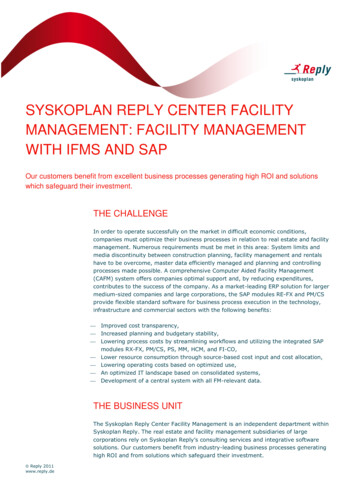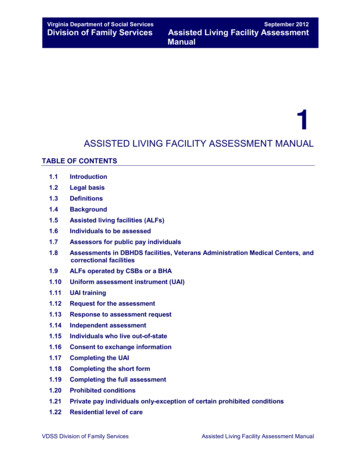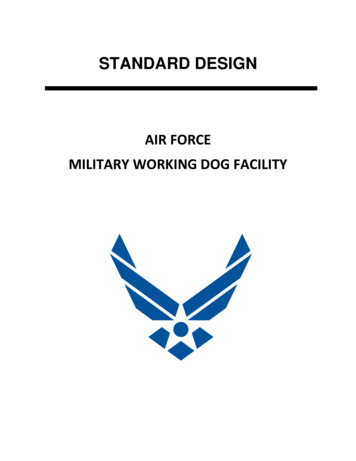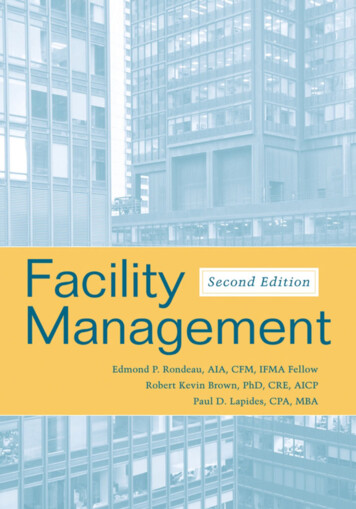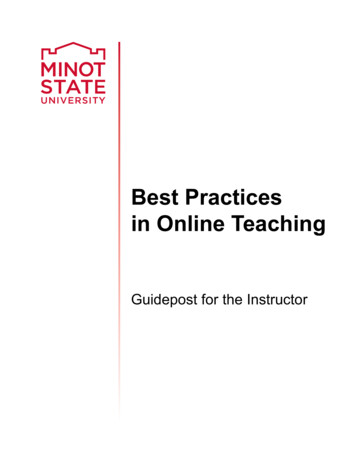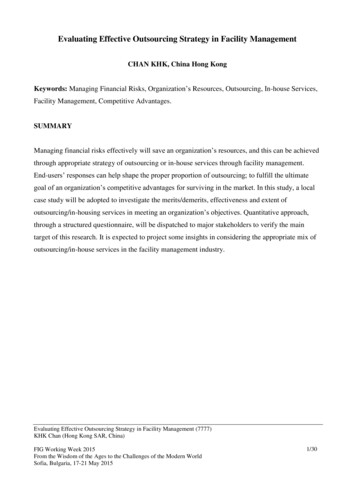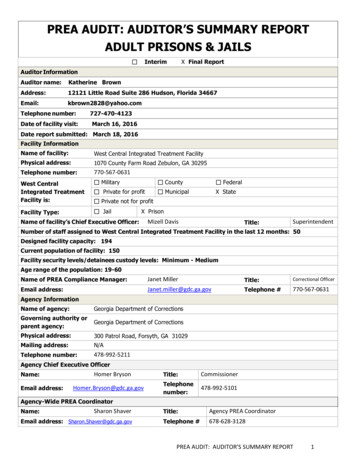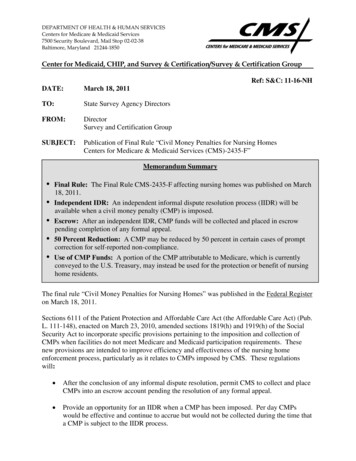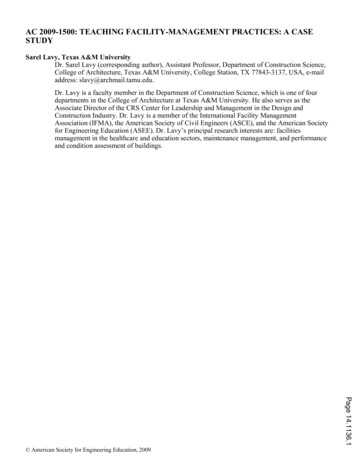
Transcription
AC 2009-1500: TEACHING FACILITY-MANAGEMENT PRACTICES: A CASESTUDYSarel Lavy, Texas A&M UniversityDr. Sarel Lavy (corresponding author), Assistant Professor, Department of Construction Science,College of Architecture, Texas A&M University, College Station, TX 77843-3137, USA, e-mailaddress: slavy@archmail.tamu.edu.Dr. Lavy is a faculty member in the Department of Construction Science, which is one of fourdepartments in the College of Architecture at Texas A&M University. He also serves as theAssociate Director of the CRS Center for Leadership and Management in the Design andConstruction Industry. Dr. Lavy is a member of the International Facility ManagementAssociation (IFMA), the American Society of Civil Engineers (ASCE), and the American Societyfor Engineering Education (ASEE). Dr. Lavy’s principal research interests are: facilitiesmanagement in the healthcare and education sectors, maintenance management, and performanceand condition assessment of buildings.Page 14.1136.1 American Society for Engineering Education, 2009
Teaching Facility Management Practices – A Case StudyAbstract: The significance of facility management to the business success of companies andorganizations is steadily increasing. Nowadays, teaching facility management is often spreadover a number of disciplines, among them engineering, architecture, management, business, andconstruction. This paper presents a case study of a project completed by teams of undergraduateand graduate students in the courses “Specialty Capstone” and “Introduction to FacilityManagement,” offered by a large university in the US in the spring 2008 semester.Facility management, if well-organized and well-structured, has the potential to not only improvethe physical performance and appearance of a building and its systems, but also to increase theusers’ level of satisfaction, and to improve the efficiency with which buildings are maintained,operated, and managed along their service lives. These two courses offered students anopportunity to encounter real problems and dilemmas that facility managers witness on a dailybasis. Students were asked to offer creative solutions to these dilemmas.The students studied several aspects of facility management, such as strategic and tacticalplanning, maintenance and repair, operations and energy management, benchmarking andcondition assessment, space allocation, and Life Cycle Costing on a local hospital campus. Thestudents in each course were given different assignments, based on their skills and level ofknowledge. Assisted by the Director of Plant Operations Maintenance and Engineering at thehospital, and using software contributed by an external commercial engineering and constructioncompany, the students collected the data and conducted the analyses shown in this paper as partof their course assignments. The concepts of teaching facility management, as implemented inPage 14.1136.2these courses, are discussed in this paper, and demonstrated through real life cases.
Keywords: Graduate Education, Undergraduate Education, Facility Management, Case Study,Condition Assessment.IntroductionThe significance of facility management (FM) to the business success of companies andorganizations is steadily increasing. Business success is characterized not only by annual revenueand profit margins, but also by the way various aspects of the building portfolio and environmentare maintained and operated. Examples for this include, but are not limited to, monitoring dailymaintenance, operations, and energy consumption; conducting condition assessments andbenchmarking studies; adapting and complying with policies and regulations; and assisting withthe implementation of the organization’s strategic and tactical planning. Often, facility managersalso confront stringent budget constraints; therefore, tools to assist in their decision makingshould be developed and offered.Universities, in a broad sense, are educational entities imparting higher education atundergraduate and graduate levels and providing opportunities for research and development.Universities offer academic programs to fulfill their goals of providing relevant education in thedesired field. Academic programs are formulated with a required course structure and generallyprovided with a degree or certificate. One can argue that a higher level of educational outcomeand usefulness of courses offered in a program are very essential for universities1; however, notPage 14.1136.3only academic programs, but also the course and the curriculum, must align with program
objectives2. Programs differ greatly in terms of their aims and objectives, structure, availableresources and degree or certificate offered for different universities. Such factors are actuallyindicative of varying standards and levels. Typically, teaching facility management encompassesseveral disciplines, among them engineering, architecture, management, business, andconstruction. As a result, it has not traditionally been well developed enough in any of theseprograms to a level that covers the large variety of topics and aspects of facility management.Today, there are only six universities in the US that offer a degree in facility management;several other universities offer courses in facility management. Those with full degree programsare Brigham Young University (College of Engineering and Technology), Cornell University(College of Human Ecology), Ferris State University (College of Engineering Technology),Georgia Institute of Technology (College of Architecture), Pratt Institute (School ofArchitecture), and Wentworth Institute of Technology (Department of Design and Facilities).Cornell University is the only one that offers both undergraduate and graduate level degrees infacility management. While Georgia Institute of Technology and Pratt Institute offer onlygraduate programs, the other three universities offer only an undergraduate degree program infacility management.This paper presents a case study (out of five that were developed) of a project completed byteams of undergraduate and graduate students in the courses “Specialty Capstone” and“Introduction to Facility Management,” offered in the spring 2008 semester. The paper discussesthe concepts of incorporating facility management aspects into both graduate and undergraduatePage 14.1136.4
level courses, and presents a case study that demonstrates how facility management isimplemented in one healthcare facility building.BackgroundMany definitions exist for the term “facility management” (FM.) The International FacilityManagement Association defines FM as: “a profession that encompasses multiple disciplines toensure functionality of the built environment by integrating people, place, process andtechnology”3. The British Institute of Facilities Management adds that: “facilities management isthe integration of processes within an organisation to maintain and develop the agreed serviceswhich support and improve the effectiveness of its primary activities”4. Other definitionsinclude: “The primary function of facility management is to manage and maintain the efficientoperation of the built environment”5; “Professional FM involves the permanent analysis andoptimisation of cost-relevant processes relating to construction-related assets, facilities andservices provided in businesses As assets become more and more sophisticated to manage, thechallenges on FM are increasing, both in terms of services to be provided and relating theresponsibilities involved”6. Additional definitions may be found in 7, 8, 9, 10, 11, 12, and others. Fromthese definitions one can conclude that facility management:is a multi-disciplinary profession; supports businesses and organizations; ensures functionality and manages the efficient operation of the built environment; fulfills people’s basic requirements at work;Page 14.1136.5
increases return on capital; and integrates people, place, process, and technology.Nevertheless, the literature realizes three common paradoxes that still exist in the facilitymanagement profession: first, although facility management is recognized as a strategicdiscipline, most of its practitioners are found at the operational levels of their organizations;second, while FM aims to be at the heart of any organizational development, many services itoffers are provided by external professionals; and third, although facility management seeks tomanage changes within organizations, in most cases it is a more reactive discipline in nature thana proactive one13, 14, 15, 16.MethodsThe courses “Specialty Capstone” (undergraduate level) and “Introduction to FacilityManagement” (graduate level) were offered in the spring 2008 semester by the university atwhich the author is a faculty member. Eleven and seventeen students participated in thesecourses, respectively, and they were grouped into five teams of 5-6 students each where 2-3undergraduate students worked with 3-4 graduate students on each team. The students wereasked to investigate how different aspects of facility management (as described hereafter) areimplemented in hospital buildings. A local medium-size hospital was involved in the projects,and was asked to allow students to study its buildings. A commercial external engineering andPage 14.1136.6construction company was also involved in the project, by contributing its on-line assessment
software to be used by the students. The company offered guidance and assistance to the studentsthroughout the semester. The Director of the Plant Operations Maintenance and EngineeringDepartment at the local hospital assigned five buildings for the purpose of these courses. Basedon the literature of topics included under the definition of facility management, the students wereasked to study the following aspects of the buildings assigned to them:1. Strategic and tactical planning – long-term, mid-term, and short-term planning;2. Benchmarking, Key Performance Indicators, and implementation of physical conditionassessment – development, assessment, and use;3. Maintenance and repair – policy setting and how it is implemented in the differentbuilding systems (structure, exterior and interior components, electro-mechanicalsystems, other);4. Operations and energy management;5. Workplace design, interior space planning – allocation, management, and forecasting;6. Use of databases for the various aspects of facility management;7. Life-Cycle Cost analysis of the building and its systems;8. Architecture/Engineering services – assessment, programming, planning, design,estimating, documenting, and contracting;9. Construction and project management;10. Financial management – budgeting, accounting, forecasting, and implementing;11. Alteration, renovation, and reconstruction management;12. Information and Communication Technology – telecommunication, data-communication,and network management;Page 14.1136.713. Security and life-safety management;
14. General administrative services – food, mail management, health programs; and15. Other issues related to facility management – this remained open to the students’selection.The above list also outlines the topics covered in the two courses. Emphasis was given tomaintenance and repair, and Life-Cycle Cost analysis in the undergraduate course, where morein-depth study of these topics was conducted in the graduate level course. The topics werecovered through class discussions, reading textbook materials and research papers, site visiting,and listening to lectures offered by guest speakers. During guest lectures during the semester,students had a chance to listen and learn from experts in different areas of facility management.The guest lecturers were representatives from the hospital, consulting companies, real-estateexperts, and facility managers from other organizations. Students were expected to incorporatethe topics listed above into their final projects. Their academic performance was assessed with acombination of their grades on the mid-term report, mid-term presentation, final report, and finalpresentation of the projects. The following paragraphs demonstrate some of the topics that werediscussed in the class, in the context of a case study of facility management practices in hospitalbuildings.Case StudyThe hospital was built in 1912 with the construction taking one year; it was a three story buildingPage 14.1136.8with a capacity of 25 beds and six bassinets. The hospital was purchased by two doctors in 1934,
and was later purchased by the Sisters of St. Francis in 1936. The hospital currently has 235acute-care beds, and a 61-bed rehabilitation and skilled nursing facility. The hospital owns threerural hospitals and two long-term care facilities. This case study focuses on the AdministrationWing, which is part of the main building complex.Areas and Organizational StructureThe Administration Wing, built in 1991 with an area of approximately 63,000 sq-ft, is part of themain building complex and it houses offices, laboratories, education centers, and meeting rooms.The building is comprised of a basement and three floors. The Education Center of the hospital islocated in the basement of this building. The first floor, also known as the main floor, containsthe main hospital entrance, a gift shop, cafeteria and some offices. Laboratories are located onthe second floor of the building, and the administration office is located on the third floor. Apartfrom the overall administration of the hospital, the services offered in the building are thelaboratories. A breakdown of the areas in the building is shown in Table 1.The hospital is run by a Board of Trustees, which is in charge of the overall management of thefacility. Under the Board of Trustees, the hospital has a President and a Chief Executive Officer(CEO), who make the strategic plans, policies, etc. The Chief Operating Officer (COO) isresponsible for the daily operations of the organization, and reports to the President and theCEO. Lower management is comprised of people in-charge/managers looking after safety,security, materials, emergency, utilities, etc.Page 14.1136.9
Area 86Table 1: Breakdown of floor areas in the building studieda– Hospitalization areas include all hospital wards, emergency rooms, operation rooms,maternity wards, premature infant care units, etc.b– Administration areas include management and administrative offices.c– Utility areas include laundry, kitchen, warehouse, etc.d– Energy-related areas include energy spaces and room, electricity rooms, machine rooms,gases storage areas, water treatment, etc.e– Laboratory areas include blood laboratories, chemotherapy, MRI, etc.f– Outpatient clinic areas include outpatient and day-care clinics (areas that usually do notprovide services during the night).g– Other areas include areas that cannot be attributed to any of the previous categories, such aslobby, entrance hall, cafeteria, etc.Page 14.1136.10
The facility management department (officially called “Plant Operations Maintenance andEngineering Department”) is extremely active in a job which ranges from picking up trash, tolandscaping and demolition of buildings, to constructing a new building. The students wereasked to interview the director of the Plant Operations Maintenance and EngineeringDepartment, where the various challenges faced by the department due to the shortage of fundsand the prioritizing of budgets were all discussed during these interviews. The departmentconsists of 34 employees in the following disciplines (the number of employees in eachdiscipline is in parentheses): facility managers (2); secretary (1); telecom coordinators (2);supervisors (3); electricians (4); plumbers (2); HVAC technicians (2); general mechanics for allpurpose maintenance (7); carpenters and painters (9); plant operator (1); and groundskeeper (1).The hospital uses both in-house and outsourced service providers. The basic services likeplumbing, electricity, painting, mechanical, etc., are provided by in-house employees, while the“large scale” services, like flooring, roofing installation, etc., are outsourced. According to themaster electrician, any activity which takes three weeks or longer, and requires three or moreworkers is outsourced.The responsibilities of the department are wide-ranging: the department is responsible forproviding maximum comfort to all people, be they patients or employees. The department is incharge of providing their best service to keep the environment of the hospital as comfortable aspossible. This ranges from keeping track on the age of the carpet, the chillers, or the boilers, tothe installation of new roofing material, or landscaping flower beds around the exterior.Page 14.1136.11
Strategic and Tactical PlanningThe hospital’s 30-year strategic plan includes extensive plans to renovate and expand its campusto create a Health District campus. Negotiations are currently in place to acquire property fromsurrounding owners to accomplish the strategic plan. The Administrative Wing, in comparison,has no strategic plans aligning with the future growth of the organization as a whole.Conversations with administrators and managers of the facility led the students to believe that theAdministrative Wing will continue to serve its current purpose of housing senior executive staffand in-house laboratory facilities.The expansion plan depends on forecasts of population growth in the area. Authorities haveconcluded that there was a 15% increase in the population over the previous 15 years. Whenadministrators see an increase in patient intake capacity, then a proportionate increase in the staffmembers is authorized. As far as the facility management department, the Director of PlantOperations Maintenance and Engineering commented that they happen to be minimally involvedin strategic planning development for the hospital. He explains this by the fact that strategicplanning is too broad and less technical. This contradicts the literature that argues that the facilitymanagement department should play an important role in developing strategic and tacticalplanning for the organization it serves.Maintenance and RepairPage 14.1136.12
As the availability of operational equipment in a safe and comfortable environment directlyaffects patient care and the hospital’s mission, it is departmental policy “to make repairs toequipment in a timely and cost efficient manner.” The rapid completion of repairs to equipmentand preventive maintenance also have a direct impact on the budget; therefore, repairs areprioritized in the following order: (1) safety related work requests; (2) patient care related workrequests; (3) periodic work and preventive maintenance; and (4) corrective maintenance, asprioritized by supervisors.All work order requests are assigned to an individual for repair. An open work order requestremains in the work order binder until completion. To assist in the tracking and completion ofwork orders, the FM department utilizes an array of performance indicators. When an outsourcedvendor is utilized to complete or assist in the completion of repairs, a copy of the receipt orvendor work order is reviewed by the director and given to the FM department’s secretary forrecording purposes. Each activity must be documented appropriately, whereas departmentalpolicy is that a job is not complete until the documentation is completed. The departmentmaintains several logs in which all maintenance items should be reflected; for example,Emergency Generator Log, Fire Sprinkler Log, Filter Log, Daily Rounds, Electrical ReceptacleTest Log, Kitchen Hood Inspection, Water Chemistry Test Log, and Vehicle Log.The students were asked to review maintenance records and find out different performanceindicators, such as the percentage of in-house vs. outsourcing work orders performed, percentageof in-house vs. outsourcing costs, and the percentage of preventive vs. corrective maintenancePage 14.1136.13conducted. The following text is quoted from the students’ report: “The first component that we
focused on was the computerized facility maintenance system, or should we say a lack there of.When we first started researching this matter we found that the only records kept by the facilitymanager and his staff were really of no help at all. The records that were kept dealt with manhours and specified in which rooms work had been completed. There was no detail describingwhat activity was conducted or what was fixed. On top of this, the information that was recordedhad been put in a format that only the director could read, which made if very difficult for therest of his staff and ourselves to comprehend. When we consulted with him about this, the onlyexcuse he had is that it wasn’t cost effective for him or anyone else to keep such detailed records.As a response to this we came up with a few suggestions. First of all, any maintenancemanagement system is better than nothing, even if it is a very simple form. It needs to includewhether the work was done in-house or outsourced, the date it was completed, and the cost of therepair (both man-hours and materials). We also suggested he keep some type of data sheet thatcontained information on the life expectancy of repairs and the budget for future repairs andreplacements.” From this text, one can learn that even though there are policies in place,regulating how these records of maintenance activities should be stored and kept, the data is noteasily tracked and/or followed by someone outside the system.Renovation and reconstruction is taken care by the facility management department of thehospital. The hospital has a five year renovation plan for the entire Administration Wingbuilding. Since the building under study is not very old construction, there has been notremendous renovation, as compared to the other buildings of the hospital. However the interiorsof the building demand repairs and renovation quite often, for the leaking roof or the torn carpet,Page 14.1136.14for example. The carpet on the first floor of the building is changed every year due to heavy
traffic, while that on upper floors is changed every two years. The boilers and chillers arereplaced every ten years; this is performed by an outsourced service provider.Operations and Energy ManagementThe Director of Plant Operations Maintenance and Engineering Department acknowledged thatenergy management systems are lagging, compared to other best practice organizations.However, the department uses Energy Star appliances throughout the laboratory installations,the office spaces, and the lavatories. There are plans, in the form of capital projects, whichinclude the acquisition of an automated Energy Management system. Costs are currently beingcalculated for the present Administration Wing building, since allocation plans intend to capturethis facility as a stand-alone profit center rather than a standard expense center.Workplace Design and Interior Space PlanningThe workplace is designed, keeping in mind the safety and comfort of patients and employees ofthe facility. Safety is given top priority in the organization and the hospital offers no compromisefor the same. The facility was designed by architects/designers with prior experience in thehealthcare industry, which is a very specialized field. It was a teamwork process, in which theauthorities from the hospital sat with the architects and designers to give their requirements. Theusers of the facility were also involved in the design, as suggestions were solicited fromdepartment heads, physicians, and nurses. The hospital was designed as per the codes set by localPage 14.1136.15authorities.
The work place is designed in such a fashion that changes to the existing structure can be easilyaccommodated. As the healthcare industry experiences frequent technological advancements,incorporating changes is difficult at times; therefore, the design of the hospital is such that anychange would not have an adverse effect on the building shell.Financial ManagementOperations at the hospital accrued a total annual distribution of almost 3 million for the entiremain campus for the FY2008. Financial budgets are developed at the senior management level.They do not, usually, allocate any funds to the facility management department for preventivemaintenance, but do allocate funds to finance capital projects, such as chiller or boilerreplacements. The preventive maintenance budgets are established on an “as needed” policy andarise from annual budget meetings as designated by the Executive Committee. The “as needed”budgets are determined on the basis of request for work-orders and upon the monthlymaintenance inspection of equipment. The maintenance inspections are performed by themaintenance staff possessing specific skills. In any case, the budgets are mostly projected fromthe life-cycle cost of each product/material expended.Life Safety ManagementThe life safety systems, like fire hydrants, are regularly inspected by the local fire marshals, thePage 14.1136.16state Department of Health, and relevant federal agencies. Three regular drills for all the life
safety devices are conducted every month. There is a fire drill every three months where theproper functioning of the devices are checked. These inspections are performed by staff and thelocal fire marshal.The sprinkler system plays a critical role during fires; thus, this system must be in excellentcondition, and must be checked on a weekly basis. If there is any malfunction in the system, itshould be rectified as soon as possible. In addition, the smoke detectors are components of thelife safety management. In case of fire, this system should alert building occupants and theauthorities of the danger. On inspecting these systems, visually, it was found that the sprinklersystem in the basement floor needs to be replaced within the next year. The smoke detectors arein good condition on all floors.Security is of prime importance to this hospital, which has hired seven security officers who arein charge of security around the clock. The visiting hours are between 9am and 9pm; the doorsare equipped with remote computer locks and they are closed by 9pm. The hospital is patrolledby these security personnel at regular intervals.Benchmarking and Key Performance Indicators (KPI’s)The hospital uses an array of benchmarks to stay current with quality practices. The facilitymanagement department benchmarks with 500 best-in-practice organizations in the United Statesthrough the use of a common database. The benchmark metrics compare the main factors ofPage 14.1136.17productivity and efficiency on a regular basis. This comparison tool provides access to databases
with information in four primary categories -- clinical services, business operations, patientsatisfaction, and safety. The comparison tool is Internet-based, and it allows the hospital toevaluate their performance against internal goals, peer groups and national benchmarks.Examples of the main KPI’s used within the FM department include the average time for a workorder to be completed, and the percent of maintenance inspection completed in the facility withina given period of time. Using this comparison strategy, the hospital aims to stay within the top25% of organizations in these various performance indicators. The performance is recordedquarterly, and later an annual performance chart is prepared and analyzed internally for planningfuture activities, and evaluating employees. Based on the benchmarking results, the hospitalreceived the 2007 Award for Performance Excellence from the state in which it is located.Condition AssessmentThe condition of the building is assessed by the in-house employees on a weekly basis. Based onthe deficiencies and the funds available, priorities are set, and based on these priorities, the workis carried out. To complete their assignment, the students were asked to go over a list of itemsand conduct a visual condition assessment in the building they studied. The following paragraphssummarize the findings of the students’ condition assessment in the Administration Wing.“During the visual assessment of the building, except for some minor defects, the building andits different components looked in good shape. The interiors components of the building, such aswalls, ceiling are in good condition, as they are renovated every five years. The carpet is changedPage 14.1136.18every year. Picture 1 shows that there is a leak on the first floor, where the leak should be
repaired and the acoustic tiles need to be replaced. In some of the areas, the wallpaper is peelingoff and needs to be replaced. Normally, the wall paper is replaced every five years. In some areasthe paint is peeling off (see Picture 2), which could have happened by impact on the wall bysome hard objects. The intensity is, however, low, and this is not a top-priority repair. No leakswere found while inspecting the restrooms. Overall, the interior of the building, except someminor defects, is in good condition and maintained periodically.”Picture 1: Acoustic tiles on the first floor“The physical condition of the structure was examined from the basement and the elevator shaft.In these mentioned areas, the walls have not been painted or covered by wall paper. Byexamining, it was found that the building is in good condition. The structure does not have anystructural cracks; the concrete does not have any irregularities. If the hospital assessors identifyany defects visible in any component of the structure, then it is given top-priority and the work isrectified as soon as possible.”Page 14.1136.19
Picture 2: Paint peeling off an interior wa
Teaching Facility Management Practices A Case Stu dy Abstract : The significance of facility management to the business success of compa nies and organizations is steadily increasing. Nowadays, teaching facility manag ement is often spread over a number of disciplines, among them engineering, architecture, management, busi ness, and construction.
